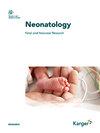Reply to "Oxygen Saturation Index: A Trigger for Neonatal Transfer?"
IF 3
3区 医学
Q1 PEDIATRICS
引用次数: 0
Abstract
Dear Editor, We appreciate the interest of Dr. Gopal and Dr. Fernandes in our studies on the use of the oxygen saturation index (OSI) as an early predictor of clinical deterioration in infants with a congenital diaphragmatic hernia (CDH). The authors propose an alternative usage of the OSI by incorporating it into assessment algorithms designed to facilitate timely transfer to higher level centers with extracorporeal membrane oxygenation (ECMO) therapy. This is an interesting suggestion, and we fully acknowledge the promising potential of OSI within such an approach, but underscore that this is particularly useful in health care systems where management of CDH infants is not centralized. Contrary to what is suggested by the authors, this is not the case for the Dutch setting, as all CDH infants are managed in two national expertise ECMO centers. Yet, in other conditions associated with hypoxic-respiratory failure, such as meconium aspiration, this indeed may be a very helpful strategy to expedite early transfer [1]. It is certainly true that most CDH infants will have arterial access, and thus OSI will not entirely replace the oxygenation index (OI), but we do want to emphasize that, in our opinion, also tertiary-care centers could profit from incorporating OSI into their management. For instance, in cases where preductal arterial blood sampling is not possible, OSI provides an interesting alternative. Also, OSI can be measured continuously and can thus potentially identify signs of clinical deterioration earlier than OI, given that the latter is a snapshot measurement that is often determined ad hoc when the clinical picture is already changing. In addition, automated analysis theoretically gives an opportunity to perform trend analysis. On the other hand, we agree that the predictive value of OSI after clinical interventions triggered by worsening or improving OSI values remains to be investigated.回复“氧饱和度指数:新生儿转移的触发因素?”
本文章由计算机程序翻译,如有差异,请以英文原文为准。
求助全文
约1分钟内获得全文
求助全文
来源期刊

Neonatology
医学-小儿科
CiteScore
0.60
自引率
4.00%
发文量
91
审稿时长
6-12 weeks
期刊介绍:
This highly respected and frequently cited journal is a prime source of information in the area of fetal and neonatal research. Original papers present research on all aspects of neonatology, fetal medicine and developmental biology. These papers encompass both basic science and clinical research including randomized trials, observational studies and epidemiology. Basic science research covers molecular biology, molecular genetics, physiology, biochemistry and pharmacology in fetal and neonatal life. In addition to the classic features the journal accepts papers for the sections Research Briefings and Sources of Neonatal Medicine (historical pieces). Papers reporting results of animal studies should be based upon hypotheses that relate to developmental processes or disorders in the human fetus or neonate.
 求助内容:
求助内容: 应助结果提醒方式:
应助结果提醒方式:


